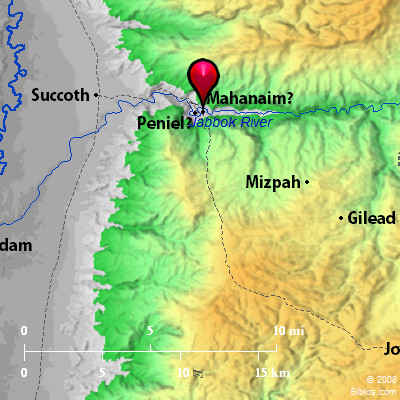Atlas  Mahanaim and surrounding area Maps Created using Biblemapper 3.0 Additional data from OpenBible.info You are free to use up to 50 Biblos coprighted maps (small or large) for your website or presentation. Please credit Biblos.com. Occurrences Genesis 32:2 When he saw them, Jacob said, "This is God's army." He called the name of that place Mahanaim.Joshua 13:26 and from Heshbon to Ramath Mizpeh, and Betonim; and from Mahanaim to the border of Debir; Joshua 13:30 Their border was from Mahanaim, all Bashan, all the kingdom of Og king of Bashan, and all the towns of Jair, which are in Bashan, sixty cities. Joshua 21:38 Out of the tribe of Gad, Ramoth in Gilead with its suburbs, the city of refuge for the manslayer, and Mahanaim with its suburbs, 2 Samuel 2:8 Now Abner the son of Ner, captain of Saul's army, had taken Ishbosheth the son of Saul, and brought him over to Mahanaim; 2 Samuel 2:12 Abner the son of Ner, and the servants of Ishbosheth the son of Saul, went out from Mahanaim to Gibeon. 2 Samuel 2:29 Abner and his men went all that night through the Arabah; and they passed over the Jordan, and went through all Bithron, and came to Mahanaim. 2 Samuel 17:24 Then David came to Mahanaim. Absalom passed over the Jordan, he and all the men of Israel with him. 2 Samuel 17:27 It happened, when David was come to Mahanaim, that Shobi the son of Nahash of Rabbah of the children of Ammon, and Machir the son of Ammiel of Lodebar, and Barzillai the Gileadite of Rogelim, 2 Samuel 19:32 Now Barzillai was a very aged man, even eighty years old: and he had provided the king with sustenance while he lay at Mahanaim; for he was a very great man. 1 Kings 2:8 "Behold, there is with you Shimei the son of Gera, the Benjamite, of Bahurim, who cursed me with a grievous curse in the day when I went to Mahanaim; but he came down to meet me at the Jordan, and I swore to him by Yahweh, saying,'I will not put you to death with the sword.' 1 Kings 4:14 Ahinadab the son of Iddo, in Mahanaim; 1 Chronicles 6:80 and out of the tribe of Gad, Ramoth in Gilead with its suburbs, and Mahanaim with its suburbs, Encyclopedia MAHANAIMma-ha-na'-im (machanayim; the Greek is different in every case where the name occurs, Codex Vaticanus and Codex Alexandrinus also giving variant forms; the dual form may be taken as having arisen from an old locative ending, as, e.g. yerushala(y)im from an original yerushalem. In Genesis 32:21 machaneh is evidently a parallel form and should be rendered as a proper name, Mahaneh, i.e. Mahanaim): The city must have been one of great strength. It lay East of the Jordan, and is first mentioned in the history of Jacob. Here he halted after parting from Laban, before the passage of the Jabbok (Genesis 31:2), "and the angels of God met him." Possibly it was the site of an ancient sanctuary. It is next noticed in defining the boundaries of tribal territory East of the Jordan. It lay on the border of Gad and Manasseh (Joshua 13:26, 30). It belonged to the lot of Gad, and was assigned along with Ramoth in Gilead to the Merarite Levites (Joshua 21:38 1 Chronicles 6:80 -the former of these passages affords no justification to Cheyne in saying (EB, under the word) that it is mentioned as a "city of refuge"). The strength of the place doubtless attracted Abner, who fixed here the capital of Ishbosheth's kingdom. Saul's ch 2 Samuel 2:8, etc.). To this same fortress David fled when endangered by the rebellion of Absalom; and in the "forest" hard by, that prince met his fate (2 Samuel 17:24, etc.). It was made the center of one of Solomon's administrative districts, and here Abinadab the son of Iddo was stationed (1 Kings 4:14). There seems to be a reference to Mahanaim in Songs 6:13 the Revised Version (British and American). If this is so, here alone it appears with the article. By emending the text Cheyne would read: "What do you see in the Shulammite? A narcissus of the valleys." MAHANA'IM, probably at Mahneh, 21 ms. e. of Jordan, and 24 s.e. of the sea of Tiberias, 66 ms. n.e. of Jerusalem. Strong's Hebrew H4266: Machanayim"two camps," a place East of the Jordan |



